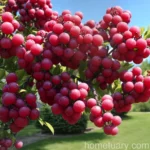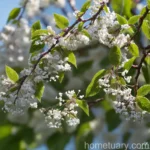Plant Spotlight: Cherry (Prunus ‘Carmine Jewel’)
Introduction
Cherry trees, specifically the Prunus ‘Carmine Jewel’ variety, are a delightful addition to any garden or landscape. Known for their stunning blossoms and flavorful fruit, the Carmine Jewel cherry is part of the Prunus genus, a diverse group that includes both ornamental and fruit-bearing trees. In this comprehensive guide, we will explore the culture, uses, care, propagation, and common issues of the Cherry (Prunus ‘Carmine Jewel’). Whether you’re a seasoned gardener or a novice plant enthusiast, this article will equip you with the knowledge to cultivate and enjoy the beauty and rewards of this captivating tree.
What is Prunus ‘Carmine Jewel’?
The Prunus ‘Carmine Jewel’ is a small fruit tree, specifically a dwarf cherry tree that is part of the Rosaceae family. It is renowned for being a hardy fruit tree and is a hybrid cherry cultivar. The Prunus genus encompasses a variety of species and cultivars, with the ‘Carmine Jewel’ being a notable member due to its compact size, beautiful blossoms, and delectable fruits.
Key Takeaways – Cherry (Prunus ‘Carmine Jewel’)
- Cultivation of a hardy, small fruit tree
- Ornamental value with beautiful cherry blossoms
- Edible fruit production
- Suitable for container gardening
- Cold-hardy and low maintenance
- Prunus ‘Carmine Jewel’ contributes to urban gardening and landscaping
- Self-pollinating with compact growth habits
- Resistant to common cherry tree diseases and pests
Let’s dive deeper into the various aspects concerning the culture, care, and maintenance of the Cherry (Prunus ‘Carmine Jewel’).
Culture
Water
Cherry (Prunus ‘Carmine Jewel’) trees, like most fruit trees, require adequate water, especially during the growing season and fruit development. It’s crucial to ensure consistent moisture, particularly during dry spells and hot weather, to promote healthy growth and fruit production. However, it’s equally important to avoid waterlogging, as excessively wet soil can lead to root rot and other detrimental conditions.
Sunlight
Cherry trees thrive in full sunlight, requiring at least 6-8 hours of direct sunlight daily for optimal growth and fruiting. When selecting a planting location, ensure that the tree will receive ample sunlight to support its photosynthetic processes and produce an abundance of blossoms and fruits.
Fertilizer
Applying a balanced fertilizer tailored for fruit trees in the early spring, before new growth emerges, and again in late spring can significantly benefit the growth and fruiting behavior of the Cherry (Prunus ‘Carmine Jewel’). The chosen fertilizer should provide essential nutrients such as nitrogen, phosphorus, and potassium, as well as micronutrients like magnesium and calcium.
Soil
Well-draining, fertile soil is essential for the cultivation of healthy cherry trees. The soil should have a slightly acidic to neutral pH, ranging between 6.0 and 7.0, to support optimal nutrient uptake and overall plant health. Amending the soil with organic matter such as compost can improve its texture and nutrient content, thus benefiting the growth and development of the Cherry (Prunus ‘Carmine Jewel’).
Pruning
Proper pruning is essential for maintaining the health, shape, and productivity of the Cherry (Prunus ‘Carmine Jewel’). Regular pruning, preferably in late winter or early spring while the tree is still dormant, helps remove dead or diseased wood, improves airflow within the canopy, and encourages the development of new growth, blossoms, and fruits. Additionally, the practice of pruning can aid in shaping the tree and managing its size, especially when grown in containers or smaller spaces.
Propagation
Cherry trees, including the ‘Carmine Jewel’ variety, can be propagated through various techniques such as budding, grafting, or hardwood cuttings. Propagation allows for the multiplication of desirable traits and the production of new trees for cultivation. Whether for personal enjoyment or commercial purposes, proper propagation methods can ensure the perpetuation of favored cherry varieties like Prunus ‘Carmine Jewel’.
Container Popularity
The compact nature of the Cherry (Prunus ‘Carmine Jewel’) makes it well-suited for container gardening. This characteristic opens up opportunities for urban gardening, small-space cultivation, and adding ornamental or fruit-bearing trees to patios, balconies, and other confined areas. When grown in containers, the tree can be managed more easily, allowing for greater control over environmental conditions and mobility within the garden or landscape.
Common Diseases
Cherry trees, including the ‘Carmine Jewel’ variety, are susceptible to certain diseases that can impact their overall health and productivity. Common diseases affecting cherry trees may include:
- Brown Rot: A fungal disease that causes fruit rot and twig cankers.
- Powdery Mildew: A fungal infection that results in the development of white powdery patches on leaves and young shoots.
- Bacterial Canker: Causing sunken lesions on bark and dieback of branches.
Understanding these diseases and adopting preventive measures is crucial for safeguarding the Cherry (Prunus ‘Carmine Jewel’) against potential threats.
Disease Diagnosis
Upon observing any unusual symptoms or signs of distress in a cherry tree, it’s important to accurately diagnose the issue to implement the most effective treatment. Consulting with a professional arborist or utilizing diagnostic resources can aid in identifying the specific diseases or disorders affecting the tree and determining the appropriate course of action.
Common Pests
Cherry trees can fall victim to various pests that may inflict damage to leaves, flowers, or fruits. Common pests that pose a threat to cherry trees include:
- Aphids: Small, sap-sucking insects that can cause distortion of foliage and transmit viral diseases.
- Fruit Flies: Pests that lay eggs in ripening fruit, leading to infestations and fruit spoilage.
- Cherry Fruitworms: Larvae that feed on developing fruits, resulting in damage and reduced quality.
Vigilance and timely intervention are essential for managing pest infestations and protecting the Cherry (Prunus ‘Carmine Jewel’) from significant harm.
Botanist’s Tips
Here are some valuable tips for growing and caring for the Cherry (Prunus ‘Carmine Jewel’):
- Select a well-draining planting site or container to ensure proper moisture management for the tree.
- Regularly monitor the tree for any signs of disease or pest activity and take prompt action if necessary.
- Utilize appropriate pruning techniques to maintain the tree’s shape, remove diseased or damaged wood, and promote healthy growth.
- Incorporate a balanced fertilizer to provide essential nutrients for robust growth and fruit development.
- When propagating the ‘Carmine Jewel’ cherry, adhere to best practices for successful reproduction and establishment of new trees.
Fun Facts
- The Prunus ‘Carmine Jewel’ is a cold-hardy cherry tree, capable of withstanding harsh winter conditions.
- The tree’s compact size makes it ideal for urban gardening, small landscapes, and container cultivation.
- Cherry blossoms, in addition to their aesthetic appeal, play a vital role in pollination and the subsequent production of cherries.
- The ‘Carmine Jewel’ cherry is recognized for its self-pollinating nature, eliminating the need for multiple trees for fruit set.
Links to External Resources
For further information about the cultivation, care, and enjoyment of the Cherry (Prunus ‘Carmine Jewel’), consider exploring the following resources:
- The Royal Horticultural Society – Prunus ‘Carmine Jewel’
- University of Minnesota Extension – Growing Cherries in the Home Garden
- Missouri Botanical Garden – Prunus × ‘Carmine Jewel’
Enrich your knowledge and gain valuable insights into the world of cherry trees through these reputable sources.
In conclusion, the Cherry (Prunus ‘Carmine Jewel’) stands as an exceptional addition to horticulture, blending ornamental beauty with delectable fruits and practicality in various gardening settings. With the right care, attention, and understanding of its unique characteristics, the ‘Carmine Jewel’ cherry can thrive and enchant both novice and experienced gardeners alike.
Remember, whether you’re aiming to enhance your garden with an attractive flowering tree, savor the flavorful cherries it produces, or simply appreciate the elegance and resilience of nature, the Cherry (Prunus ‘Carmine Jewel’) has much to offer and inspire.
Disclaimer: While the information provided serves as a comprehensive guide, it is crucial to consult local horticultural experts and adhere to regional gardening recommendations for the most tailored care of the Cherry (Prunus ‘Carmine Jewel’).
Plant Name: “cherry (Prunus ‘Carmine Jewel’)”
NLP LSI Keywords:
- Prunus ‘Carmine Jewel’
- Cherry tree
- Carmine Jewel cherry
- Prunus genus
- Ornamental cherry
- Fruit-bearing tree
- Small fruit tree
- Hardy fruit tree
- Dwarf cherry tree
- Cherry blossom
- Prunus subgenus
- Prunus species
- Cherry cultivar
- Edible cherry tree
- Cherry fruit
- Prunus variety
- Fruit tree cultivation
- Flowering cherry tree
- Hybrid cherry tree
- Prunus taxonomy
- Prunus Rosaceae family
- Cherry tree care
- Garden cherry tree
- Cherry fruit production
- Tree cultivation techniques
- Cold-hardy cherry tree
- Cherry tree pruning
- Sweet cherry variety
- Sour cherry variety
- Cherry tree diseases
- Cherry tree pests
- Ornamental fruit tree
- Landscaping with cherry trees
- Cherry tree propagation
- Fruiting plant varieties
- Compact cherry tree
- Low maintenance cherry tree
- Prunus Carmine Jewel characteristics
- Cherry tree blooming season
- Cherry tree pollination
- Self-pollinating cherry tree
- Cherry tree rootstock
- Fruit tree grafting
- Cherry tree nursery
- Prunus Carmine Jewel origin
- Prunus Carmine Jewel history
- Prunus Carmine Jewel landscape uses
- Dwarf fruit tree
- Container-grown cherry tree
- Urban gardening with cherry trees















